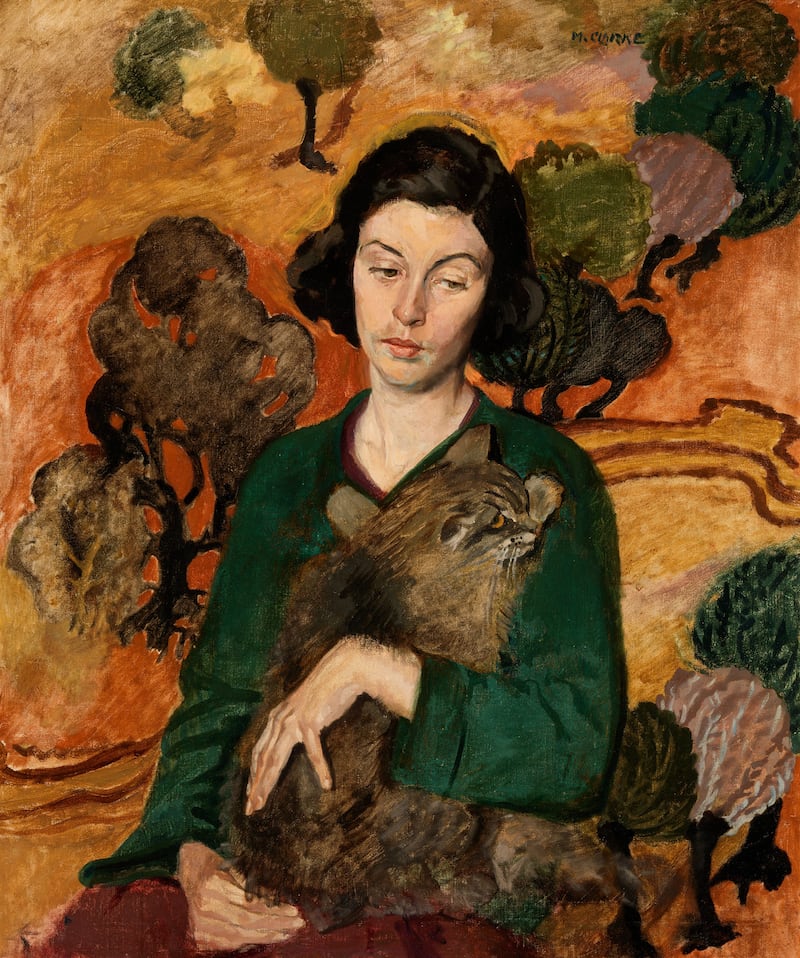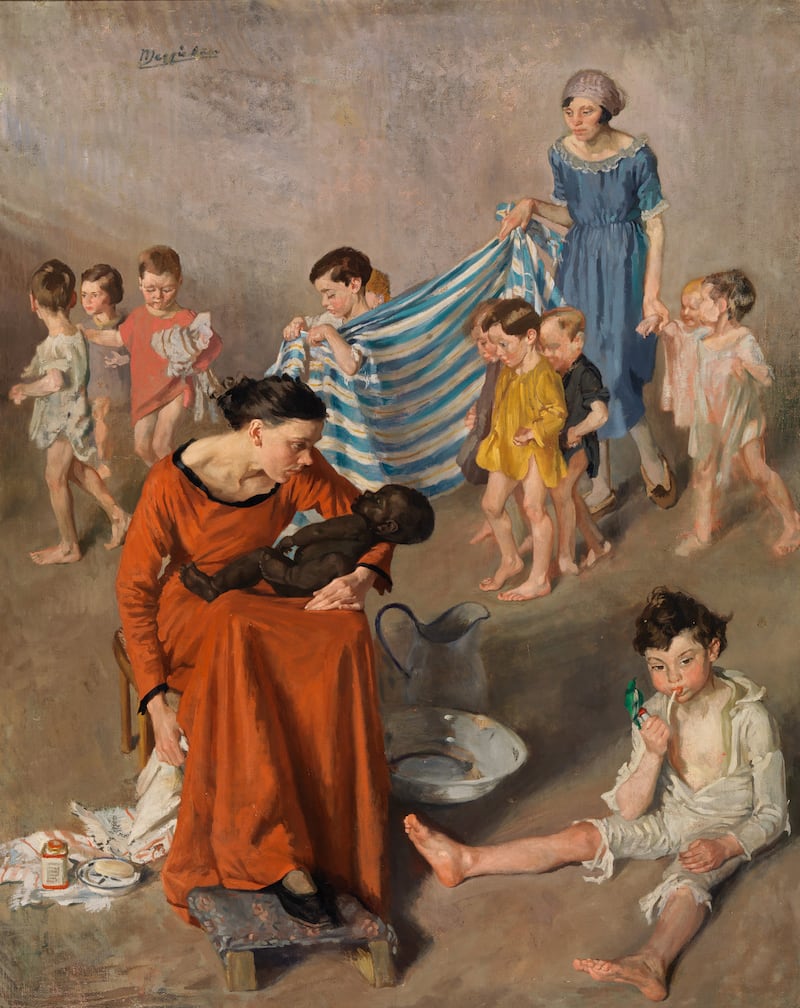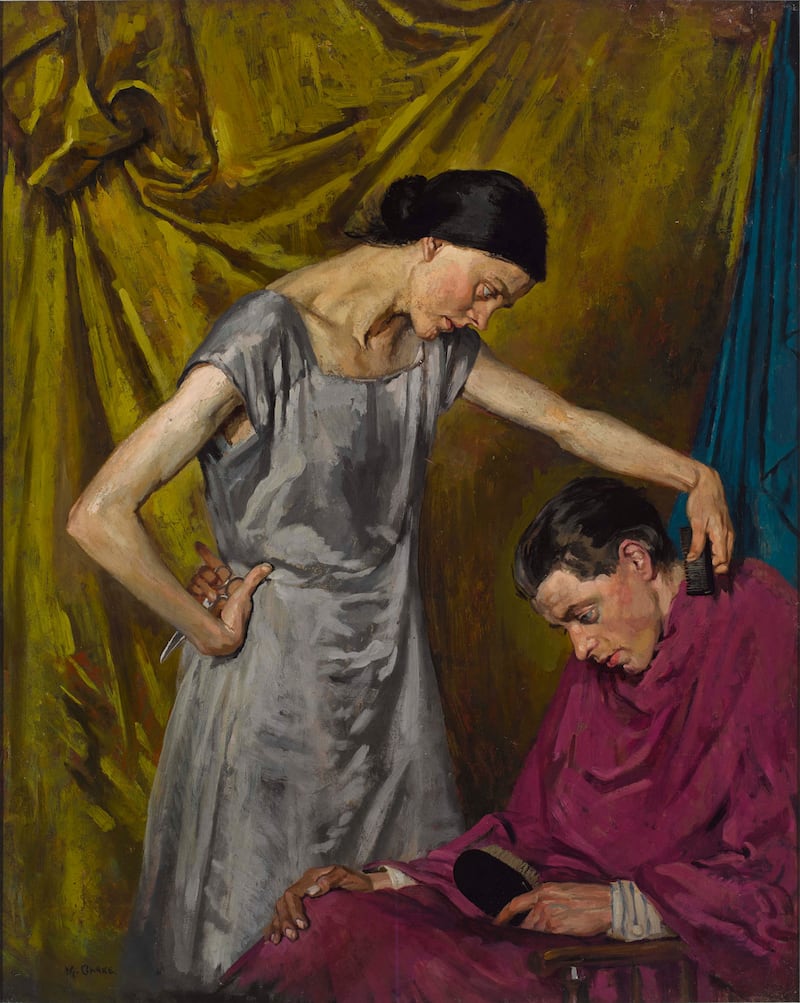By any standard, the artist Margaret Clarke, nee Crilly, was a high achiever. She was born in Newry, Co Down, in 1884 to a family in which learning was valued. She became a primary school teacher but nurtured an ambition to teach art. To that end, she first attended night classes at Newry technical school before winning a scholarship to the Dublin Metropolitan School of Art, where successive scholarships carried her through her studies.
William Orpen was a visiting teacher when she was there and he was evidently impressed. He had bought a piece of work by her, and employed her as his teaching assistant, by the time she was 22. In the next two years she won two gold medals for her painting. When Orpen moved on, she took over as a teacher in the life room.
Shortly before she married the renowned stained-glass and graphic artist Harry Clarke in 1914, she painted a fine self-portrait. It's relaxed, quietly assured, and very direct. There is a touch of formality in that her blue cardigan, blouse and brooch are not exactly typical painting attire. She appears intent but quite at ease, immensely spirited and on the verge of smiling.

With marriage came additional responsibilities, and not just those associated with becoming a mother to three children and running a household. Harry suffered from tuberculosis, and in time his growing health problems were an additional pressure on her. Apart from pursuing her own calling as a painter, which she did with great energy and consistency, she became involved with the stained-glass studio that bore his name, especially as his health began to seriously falter and he had to spend considerable periods in sanatoriums. Tragically, he was on his way home from a sanatorium in Switzerland in 1931 when, aged only 41, he died.
Afterwards, she and her daughter Ann and son David (who also became a painter) took over the running of the studios. David's involvement continued until the studios eventually closed in 1973. In the meantime, Margaret was in demand as a portrait painter; Éamon de Valera, archbishop John Charles McQuaid, Mary Macken and Lennox Robinson were among her many sitters.
She was the second woman – after Sarah Purser – to become a full member of the RHA and, besides portraits, produced landscapes, floral still lifes and ambitious subject paintings. While she was an academician, she was artistically open-minded and involved with several independent artists' groups and a founder member of the Irish Exhibition of Living Art, for several decades the most significant, progressive alternative to the RHA. She died in 1961.
Overshadowed by men
That amounts to a very full, public career, and yet she has been to a significant extent overshadowed as an artist by her husband and, arguably, by Orpen, who was clearly an influence on certain aspects of her work.
An Independent Spirit, a collaborative project between the National Gallery of Ireland and the FE McWilliam Gallery & Studio in Banbridge, aims to redress the balance and, as the title implies, allow us to see Margaret Clarke as an artistic personality in her own right. Niamh MacNally of the National Gallery curated.
One portrait of Harry, from 1929, pictures him in a sanatorium in Davos, where she visited him
Her portraits emerge as a particularly strong and important strand of her artistic activity: not least portraits of her immediate family, which, while being completely particular, have a universal resonance. They include her studies of Harry, which reflect their loving relationship. One, from 1929, unfinished but telling, pictures him in a sanatorium in Davos, where she visited him. There is an extraordinary sadness in his eyes.
Her portrait of her daughter, Ann with Cat, from 1930-31, shown at the inaugural Irish Exhibition of Living Art, is exceptional and vivacious in its bold colouring – she liked startling the viewer a little with colour, as in her portrait of her sister Mary in a scarlet waistcoat. The burst of red is a clever decoy, in a way, distracting us from the hesitancy in her sister's gaze.

Around the same time as Ann with Cat she painted a portrait of Dom Justin McCarthy of Mount St Jospeh Abbey, Roscrea, which is almost monochromatic, but quite compelling. Her study of her son, David, 1934-35, is exceptional, recalling the New Objectivity painters of the Weimar Republic. Her De Valera (in the Irish News Collection) painted on commission in 1928, is an exceptionally sympathetic account of a figure who could appear severe, even autocratic. Studies of her housekeeper and childminder, Julia O'Brien, are equally sympathetic and more – gentle, in fact.

Orpen’s influence
Moving into another arena, her narrative paintings can suggest the influence of Orpen's more allegorical pictorial efforts, which is not necessarily a good thing. This is especially true of Strindbergian, an ensemble composition with several readily identifiable sitters. It was based on Strindberg's The Ghost sonata and, like Orpen in full allegorical flight, is theatrical in a curiously arch, stilted way. Theatre could be a much more productive source. Specifically, Clarke's Ophelia, from the National Gallery's own collection, is quite outstanding. Rather than consigning her to victimhood, she has Ophelia dressed in black and sitting in woodland. For all the morbidity of the subject, there is a tremendous vitality and urgency to the painting, and to the figure, who is very much alive.
Other narrative attempts are intriguing. They include The Dressmaker, which is allegorically rich, Bathtime at the Crèche, an oddity but an interesting one, and a strange, contemporary reworking of Samson and Delilah, The Wife/The Haircut. Given her long, fruitful career, Clarke was never quite lost to public sight, but this exhibition is nonetheless welcome in providing an opportunity to see her anew.

- Margaret Clarke: An Independent Spirit is at the National Gallery of Ireland, until August 20th. Admission free. nationalgallery.ie













